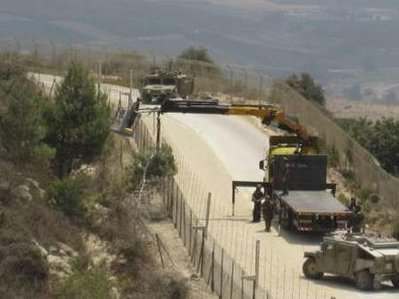How Photographs And Media Bias Cranked Up The Israel-Lebanon Border Clash
 MORE on the Gardening War – the clash between Israeli and Lebanese forces that is increasingly looking like an events staged for the media to lap up.
MORE on the Gardening War – the clash between Israeli and Lebanese forces that is increasingly looking like an events staged for the media to lap up.
READ: What Really Happened When Five People And One Tree Died On Israel-Lebanon Border
The question is this: Having told the Lebanese that they were going to cut a tree on their side of the border, why did so many photographers end up on the scene before a shot had been fired?
The Israeli pruning arm reaching over the fence did not help Israel look straight at first glance. But the fence is not on the border so trim away …
Back Spin is more interested in the photographs taken and published after and during the event, and how there came to be so many snappers on the scene with access to a military hot spot.
Before that , get a load of these captions, which were later changed. All accept an untruth as fact without first checking it. Why?
The Issues
1. Five photographers, (in addition to an unknown number of stringers) from one news service covering what was supposed to be routine IDF border maintenance work is astounding.
The Reuters photographers identified with photo credits are Ali Hashisho, Hamad Almakt, Kamel Jaber, Baz Ratner, and Karamallah Daher (not to be confused with AP photographer Ronith Daher who also covered the border skirmish). Ratner and Almakt worked on the Israeli side of the border. The rest of the images are from the Lebanese side.
2. Reuters’ coverage and access to so many positions along the border makes us wonder if some or all of these photographers expected to “only” cover IDF gardening or the start of the next Lebanon war.
Reuters’ photos simply blew away the other news agencies. Had the skirmish escalated, the wire service would have been well-poised to produce lots of gory images of dead and injured Lebanese soldiers and civilians…
4. Some images of Israeli soldiers taken from the Lebanese side of the border are so close, it’s a miracle that more journalists weren’t killed or injured by IDF fire. In the heat of battle, it’s very easy to confuse large camera equipment, like a zoom lens, with a weapon.
As it was, Assaf Abu Rahhal of the pro-Syrian paper, al-Akhbar was killed, while Ali Chouaib of Hezbollah’s Al-Manar was injured.
5. Seven of the 25 pictures (28 percent) have an unidentified “stringer” photo credit; this is very suspicious and leaves a lot of unanswered questions as to who the photographers are.
Common practice is for stringers — local free-lance photographers not employed by the news service — to be credited by name, followed by the word “Stringer” or “STR” to indicate the photographer’s status. None of the seven stringer photo credits identified anyone by name…
It should be noted that Reuters wasn’t the only agency with photographers on scene. But why make judgements in a potential war zone that could escalate a conflict? What is there to gain..?
Posted: 7th, August 2010 | In: Reviews Comment | TrackBack | Permalink



